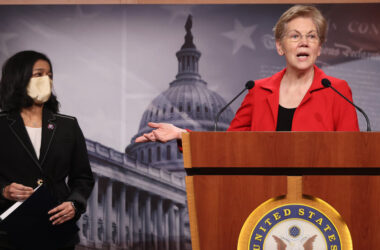The U.S. economy continued to grow at a healthy pace at the end of 2023, capping a year in which unemployment remained low, inflation cooled and a widely predicted recession never materialized.
Gross domestic product, adjusted for inflation, grew at a 3.3 percent annual rate in the fourth quarter, the Commerce Department said on Thursday. That was down from the 4.9 percent rate in the third quarter but easily topped forecasters’ expectations and showed the resilience of the recovery from the pandemic’s economic upheaval.
The latest reading is preliminary and may be revised in the months ahead.
Forecasters entered 2023 expecting the Federal Reserve’s aggressive campaign of interest-rate increases to push the economy into reverse. Instead, growth accelerated: For the full year, measured from the end of 2022 to the end of 2023, G.D.P. grew 3.1 percent, up from less than 1 percent the year before and faster than in any of the five years preceding the pandemic. (A different measure, based on average output over the full year, showed annual growth of 2.5 percent in 2023.)
There is little sign that a recession is imminent this year, either. Early forecasts point to continued — albeit slower — growth in the first three months of 2024. Layoffs remain low, and job growth has held steady. Cooling inflation has meant that wages are again rising faster than prices. And consumer sentiment is at last showing signs of rebounding after years in the doldrums.
“It’s hard to imagine how things could look better for the soft landing,” said Brian Rose, senior economist at UBS. “Looking back at last year, the combination of growth and inflation that we had was not considered in the realm of possibility by most people. To have such strong growth, low unemployment and to have inflation coming down that quickly, even the optimists weren’t that optimistic.”
The fourth-quarter data provided more evidence that the recovery remains on solid footing. Consumer spending, the bedrock of the U.S. economy, grew at a 2.8 percent annual rate, only modestly slower than the prior quarter. The housing sector, which was battered by high interest rates in 2022 and early 2023, grew modestly for the second quarter in a row. Businesses stepped up their investment on equipment. Personal income rose faster than prices as the strong job market continued to benefit workers.
Perhaps most significantly, inflation continued to cool: Consumer prices rose at a 1.7 percent annual rate in the final three months of the year, below the Fed’s long-run target of 2 percent. (Measured from a year earlier, prices were up 2.7 percent.) That isn’t just good news for households bruised by two years of rapidly rising prices; it also makes a recession less likely, because it gives Fed policymakers more flexibility to cut interest rates to keep the recovery on track.
“Even if we see some signs of recessionary forces, the Fed might be able to respond fairly quickly,” said Aichi Amemiya, senior economist at Nomura.
Risks remain. Consumers have increasingly funded their spending with credit cards and other forms of borrowing, such as “buy now, pay later” loans, which could prove unsustainable, especially if the job market weakens. High interest rates continue to ripple through the economy, and developments overseas — from conflict in the Middle East to economic weakness in China — could have domestic consequences.
Such threats don’t seem to be fazing investors, who have pushed the stock market to record highs. And businesses, too, appear to be growing more confident, stepping up their investment after a year spent girding for a possible downturn.
“I think the fears that the economy was going to slip into a recession are pretty much behind us, and it seems like businesses are planning for growth,” said Ben Herzon, an economist at S&P Global Market Intelligence.
The surprising strength of the recovery in 2023 has led some economists to question how their forecasts were so wrong.
One possibility is that they failed to see how the pandemic had rewritten the rules of the economy. The Fed has struggled in the past to bring down inflation without driving up unemployment. But this time, the rapid rise in consumer prices was driven at least in part by disruptions caused by the pandemic — and as those disruptions have eased, so has inflation.
“This cycle is historically unique; we’ve never had a global pandemic before,” said Michael Gapen, chief U.S. economist at Bank of America. “Maybe the fault was relying too much on history and too much on models.”




